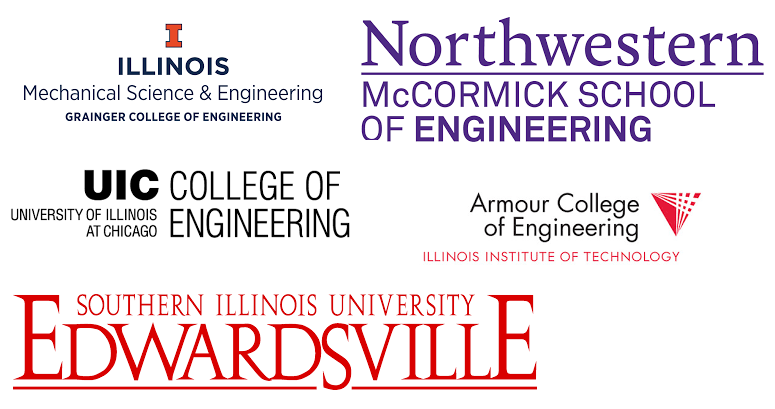This article features top engineering colleges in Illinois that offer master and doctoral degrees in the fields of biological engineering, chemical engineering, computer science, materials engineering, mechanical engineering, etc. Please be informed that each school receives national wide rank as the ranking compares all engineering schools in the United States. Some important ranking factors include average GRE scores, alumni surveys, current student interviews, institutional research publications, and peer college assessment. In the following list of best engineering schools in the state of Illinois, you can see tuition cost for both in-state and out-of-state students, acceptable rates and admissions statistics for each top ranked engineering college.

| National Ranking | Illinois Top Engineering Programs |
| 6 | University of Illinois–Urbana-Champaign (Urbana, IL) Overall acceptance rate: 25.9% Average GRE quantitative score (master’s and Ph.D. students): 774 Tuition: In-state, full-time: $15,732 per year, Out-of-state, full-time: $28,998 per year Total graduate engineering enrollment: 2,773 Research expenditures per faculty member: $571,122 Engineering school research expenditures (2010-2011 fiscal year): $220,453,475 Faculty membership in National Academy of Engineering: 4.3% |
| 20 | Northwestern University (McCormick) (Evanston, IL) Overall acceptance rate: 22.0% Average GRE quantitative score (master’s and Ph.D. students): 772 Tuition: Full-time: $41,592 per year Total graduate engineering enrollment: 1,531 Research expenditures per faculty member: $622,433 Engineering school research expenditures (2010-2011 fiscal year): $107,681,040 Faculty membership in National Academy of Engineering: 3.9% |
| 66 | University of Illinois–Chicago (Chicago, IL) Overall acceptance rate: 31.3% Average GRE quantitative score (master’s and Ph.D. students): 740 Tuition: In-state, full-time: $12,464 per year, Out-of-state, full-time: $24,462 per year Total graduate engineering enrollment: 985 Research expenditures per faculty member: $280,045 Engineering school research expenditures (2010-2011 fiscal year): $29,124,709 Faculty membership in National Academy of Engineering: 1.0% |
| 72 | Illinois Institute of Technology (Armour) (Chicago, IL) Overall acceptance rate: 59.8% Average GRE quantitative score (master’s and Ph.D. students): 739 Tuition: Full-time: $1,056 per credit Total graduate engineering enrollment: 1,523 Research expenditures per faculty member: $265,131 Engineering school research expenditures (2010-2011 fiscal year): $26,778,304 Faculty membership in National Academy of Engineering: 2.2% |
| 169 | Southern Illinois University–Carbondale (Carbondale, IL) Overall acceptance rate: 55.4% Average GRE quantitative score (master’s and Ph.D. students): 718 Tuition: In-state, full-time: $350 per credit, Out-of-state, full-time: $876 per credit Total graduate engineering enrollment: 494 Research expenditures per faculty member: $39,878 Engineering school research expenditures (2010-2011 fiscal year): $2,711,752 Faculty membership in National Academy of Engineering: 0.0% |
Nature of Illinois
The state of Illinois is located in the Midwest of the United States and belongs to the northeastern central states of the United States of America. The territory of the state of Illinois is 149,998 km 2 (twenty-fifth place among the states of the USA).
Illinois is bordered by Wisconsin to the north, Michigan to the northeast (Lake Michigan border), Indiana to the east, Kentucky to the southeast (along the Ohio River), Missouri to the southwest, and Iowa to the northwest (with both states along the Mississippi River).
Illinois is located in the United States Central Time Zone.
Almost all of Illinois is hilly plains, elevations rise only in the northwest (this is where the highest point of the state is located – Charles Mound, 376 meters above sea level) and in the south (Shawnee Hills). Illinois is located on the territory of the Great Plains of the United States and most of the state (almost all the northern and central districts) are occupied by prairies, though largely modified by human activities.
There are more forests in the south of the state, it is here that one of the largest (more than 1000 km2 ) protected forests in the USA, the Shawnee National Forest, is located. Oaks, maples, hickories grow in the forests of Illinois; in them you can see white-tailed deer, foxes, muskrats, raccoons and many other animals.
The largest river in the state (except for the border Mississippi, Ohio and Wabash) is the Illinois (more than 430 km).
Illinois has a humid continental (and subtropical in the south of the state) climate with hot summers (when the weather is determined by warm air masses coming from the Gulf of Mexico) and cool winters (when cold Arctic air comes from the north, from Canada). Precipitation falls all year round, but most of the rain falls in late spring – early summer.
The average temperature of the coldest winter month in Illinois’s largest city, Chicago, is from -8°C to 0°C, and the hottest summer month is from 19°C to 29°C. In the central state capital, Springfield, average temperatures range from -8°C to 1°C in January and from 19°C to 30°C in July. In southern Illinois, in the city of Cairo, summer temperatures range from -4°C to 6°C, and in July from 21°C to 32°C.
The vast water surfaces of the Great Lakes have a significant impact on the weather of the “Prairie State”, in particular, snow storms often occur in winter (the so-called “snow effect from the lakes”). Thunderstorms are frequent in Illinois (an average of fifty thunderstorm days per year), and destructive tornadoes are not uncommon and destructive.
